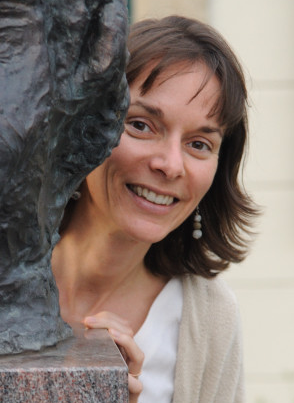Nicola Spaldin
Interview by Carey Sargent, EPFL, NCCR MARVEL, February 2019
The biggest challenge that woman scientists face is…
I would say the societal expectation that scientists should be non-female. This starts out as an expectation from families and school teachers and friends that young women shouldn’t become scientists so that they don’t explore the option. Then it manifests as unconscious bias or even active discrimination in evaluations of woman scientists’ work, as well as in gender-based harassment. I would say that the expectation probably stems in turn from the fact that there are not so many leading women scientists and so when people think of a scientist, they don’t think of somebody female.

I chose a scientific career because…
I don’t really have any other skills. I can’t think of anything I’d rather be doing than science, but I’m not sure I actively chose it, I just sort of drifted into it.
If I were not a scientist, I would be…
I think I would have been a musician. I studied music performance quite seriously as a teenager and I enjoyed it very much. I considered fairly seriously whether that was the direction I wanted to go. In the end, maybe I ended up in science instead because of a very perceptive piano teacher who pointed out that she’d heard that I was quite good in physics; I think the implication was that I wasn’t very good in piano ;)
My most exciting MARVEL discovery to date has been…
I think the most scientifically interesting and also the most enjoyable has been the collaboration with the group of Marisa Medarde at PSI. In the first phase of MARVEL we had a structured mechanism for collaboration with experimental groups and Marisa and I enjoyed a very productive collaboration through that program. Marisa was able to engineer a material in which the magnetic moments order in a spiral pattern at high temperature, which is quite unusual. Our job was to understand why this happened and then to propose modifications to the material to optimize this property, in particular to make the spiral more robust and persist to even higher temperature. The reason that we are excited about this type of magnetic spiral is that it also has the property of being ferroelectric, so that in addition to being magnetic, the material has an electric polarization. It is therefore a multiferroic – with simultaneous magnetic and this electric polarization. This is quite a rare property and potentially quite a useful one. It was really a pleasure as well as being scientifically interesting to work with Marisa on this project.
Top two papers?
My favorite paper of my own was one that I guess really started my current research direction, a paper I wrote in 2000 called “Why are there so few magnetic ferroelectrics?” The paper more posed the question than answered it, and so it set the direction for my research as well as for that of other groups, who also become interested in answering the question.
Apart from that historic one, I would say it’s always the paper that I’m about to write next because it’s new for me. I already know about the research that I have already published, so it’s no longer new and exciting.
